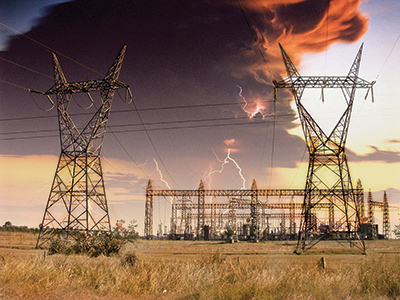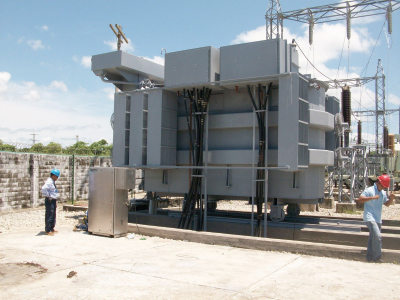Transformer management, testing and the resulting diagnoses and recommendations are said by some to be at a crossroads. Today’s many adverse factors, if not corrected, are forming ‘a perfect storm.’ Some of these major storm factors include:
- Aging fleet of transformers presently in use
- A changing workforce within the industry due to the retiring of transformer specialists
- Hesitation or budget restriction to adopt new tools or adapt to new technologies
- Inadequate frequency of testing
- Lack of testing comprehensiveness
- The sometimes insufficient or unknown quality of service specialists for service work.
Four of the most critical factors include:
1. Higher than expected failure rate of an aging fleet of transformers
Although robust in their capacity for overloads, older aging transformers are predicted to fail at higher rates due to the deterioration of their cellulose insulation, bushings and overall old age. They are becoming less and less reliable or capable of meeting the needs of their capacity requirements, especially when subjected to surge events. These older transformers – most of which were built in the ‘70s and ‘80s and still predominate – were designed and built without the foresight of electronic monitoring. Today’s lighter and more compact transformers more commonly feature electronic monitors.
It is important to recall that moisture, heat, and oxygen are the three elements that promote premature aging of the insulation. They do this individually, as well as collectively, by the formation of acids and other products that are aggressive towards the cellulose insulation.

New transformers, especially the larger ones, are rigorously confirmed at both the factory and the site. This is just the beginning of a responsible maintenance program that would include fluid testing as often as quarterly and regularly scheduled electrical testing.
2. Steady decrease in transformer expertise to build, maintain and service power transformers
It is a fact that many technical and skilled workers that truly understand the ins and outs of power transformers are approaching retirement. Their important skills and talents are fading from the work force. This diminishing resource includes electrical engineers who in past decades had selected this field of study in college, but now are pursuing more alluring careers in new fields like smart-grid automation and computer science.
Concerning manufacturing and repair, designing and fabricating transformers is a labor-intensive activity requiring special skills acquired from years and years of hands-on experience. There are simply too few mentors providing the necessary apprenticeships. Training costs have also risen.
Online testing and monitoring trends help determine ‘dry-out’ as an effective solution for transformer’s life extension
Measurement of data online proved critical for maintaining the working condition of the transformer fleet owned and operated by Northern Lights Electric Cooperative (NLI) in Sagle, Idaho.
NLI manages its transformer testing data through SD Myers, Inc. (SDMI) Transformer Dashboard, a web-based service with access to all testing data 24/7 and a multitude of charting data displayed graphically with the touch of a button. Through this data interface, SDMI’s diagnostics group and engineers were able to notice the trending problem with one of NLI’s major 230 kV, 5,000-gallon substation transformers.
A report generated by Transformer Dashboard charted a pattern of unacceptable moisture saturation levels in the transformer oil, with the water content in the oil at times exceeding 50-60 ppm. The percent saturation level was important because it reflects the potential for moisturerelated failure. Also, over 100 times more moisture resides in the paper insulation than in the oil. Parts per million levels may be low and appear acceptable at lower temperatures, but this can be misleading, because the percent saturation is high under these conditions. Based on the report, NLI was able to determine the best route to extend the life of its problem transformer.
NLI applied an SDMI’s DryMax transformer dehydration unit to dry out the oil and paper insulation. Subsequent trending showed that moisture levels were reduced to acceptable 10 ppm levels during the first month. After eight months, the dehydration unit reduced the water content to 2 ppm, with a now acceptable level of relative saturation of under 3 percent. The moisture problem was solved due to SDMI’s and NLI’s ability to observe trending data, verify the condition and NLI’s management decision to correct the problem.
About the author
Clint Brewington, System Engineer at Northern Lights Inc. (NLI) in Sagle, Idaho.
The labor force committed to maintaining and servicing these transformers is experiencing the same labor and skills shortages as the fabricators working in the shops. This includes special skills in fluid processing, electrical testing, vacuum filling, and oil testing – skills that can take years to develop including rigid safety requirements.
3. Transformer testing providers with limited scope of expertise
The Institute of Electrical and Electronics Engineers (IEEE) C57 standards have recommended that transformers rated above 500 kVA be electrically-tested annually. In actuality, this recommendation is often overlooked; and in practice, most transformers are tested every three to five years. Some owners have even extended electrical test intervals out to six- and eight-year cycles.
Often, when it comes to assessing the current condition and ‘expected life’ of transformers, fluid testing is the only analytical and diagnostic tool employed. While they might appreciate the influx of work, fluid-testing labs are not purposely leading owners/managers into believing that fluid testing is all that is needed to assess their electrical equipment condition. Even though fluid testing is essential, these economical and important tests do not provide the total picture. It has been noticed, however, due mostly to budget considerations, that if the more expensive electrical tests do not seem urgent, then fluid testing is continued on schedule with electrical testing called upon only if an abnormality surfaces.
In addition, the quality of sampling and testing procedures is often lacking if industry standards and best practices are not complied with closely.
The following are some important qualifiers to consider when engaging fluid-testing labs:
- Do sampling technicians record the fluid level, pressure/vacuum gauge reading, top gauge temperature and sample temperature?
- Do they note the paint condition and the presence of any leaks? These are simple tasks that should be performed during any routine inspection or fluid sampling.
- Do sampling technicians extract a representative sample of the dielectric fluid? Are the proper sampling containers used?
- Do the laboratories test for and trend the acids, oxidation, contaminants, oxidation inhibitor, moisture, dissolved gas, and furans?
- Do the laboratories provide testing and maintenance recommendations based on the fluid test results and their trending over time?
As noted earlier, in many power delivery settings, electrical testing is neglected past recommended intervals. These tests are important in determining the health of the transformer and remedial actions required to assure reliability and extend life. Electrical testing can be used to determine if internal inspections are needed. Such inspections may reveal internal issues depending upon the location of the problem.
The following electrical tests provide critical information on the health of the transformer:
- Doble power/dissipation factor testing
- Excitation/winding resistance/TTR/ Megger testing
- Power factor testing of the bushings
- Hot collars testing of the bushings and arrestors
- Measuring the leakage current of the arrestors
- Sweep Frequency Response Analysis (SFRA)
- Partial discharge testing
- Leakage reactance testing
- Frequency domain testing

Transformer Specialist Certification Program contributes to Hawaiian utility expertise
John Emmons was a Predictive Maintenance Specialist at Hawaiian Electric Co. (HECO), Pearl City, Hawaii, when he became certified as a Master Transformer Specialist at SD Myers’ Training & Education Center, Tallmadge, Ohio. HECO is Hawaii’s main utility serving 95 percent of the state’s 1.2 million residents.
“The knowledge and wisdom I acquired through SD Myers, Inc. (SDMI) Transformer Specialist Certification Program gave me the confidence to take on more challenging tasks within my company,” Emmons explained. “SD Myers provided an indepth learning experience that I could not find anywhere else. The program elevated my level of knowledge of transformers well above where I had been. I was able to widen my scope of plant operations and maintenance, which ultimately led to a promotion to Resource Planner.”
Emmons recommended to HECO management that the rest of his crew could benefit from knowledge similar to what he had received. The utility agreed and SDMI flew in a team to Hawaii, administering instruction and on-site training to 32 additional HECO staff.
[image of author]
About the author
 John Emmons has been with the HECO for just under four years. He came to the utility after nearly 11 years with Aloha Airlines working as a lead aircraft electrician assigned to the inspection, troubleshooting, and maintenance of their fleet of Boeing 737-700 and 737-200 series commercial jets. Prior to that, John spent 20 years in the United States Air Force as an avionics technician working on trainer, fighter, and cargo military aircraft. He is a proven manager, administrator, planner, and trainer.
John Emmons has been with the HECO for just under four years. He came to the utility after nearly 11 years with Aloha Airlines working as a lead aircraft electrician assigned to the inspection, troubleshooting, and maintenance of their fleet of Boeing 737-700 and 737-200 series commercial jets. Prior to that, John spent 20 years in the United States Air Force as an avionics technician working on trainer, fighter, and cargo military aircraft. He is a proven manager, administrator, planner, and trainer.
At the end of the day, what’s really needed is a transformer maintenance provider that offers more than oil sampling and analysis. Additional expertise is required in electrical testing, moisture management, oil processing and reclamation; and ancillary components such as bushings, arrestors, de-energized tap changers (DETCs) and load-tap changers (LTCs). Such broad expertise is needed for a full and accurate view of the transformer’s condition. This data can be powerfully presented in organized, electronically-accessible ways and utilized as a ‘dashboard’ to help maintain reliability.
4. Slow or non-adoption of modern monitoring and data management tools
Generally speaking, utilities are known for embracing proven, new technologies in monitoring and data management. Increasingly, monitoring and data management equipment manufacturers are developing better quality instruments more effective in detecting such problems as excess moisture and dissolved gasses. Some of these types of monitors can detect moisture plus fault gasses from partial discharge, general overheating, hot-spot overheating, and arcing. Often such monitors can be remotely monitored via the Internet and provide alarm notifications. These systems provide timely and valuable information to implement appropriate action. Always important to these data and their evaluation is the historical trending.

According to Powell Industries’ PowlTech division, online electronic monitoring is becoming increasingly more prevalent with the communication advancements of intelligent electronic devices (IEDs) such as electrical metering and protection relaying devices. These advancements have given plant personnel the ability to see into the window of their electrical system to maintain continuous power and determine the cause of, mitigate and predict electrical issues. In general, transformer automation deals with the replacement of analog measurement, protection, and control mechanisms with electronic devices. These instruments, which include IEDs, digital fault recorders and power quality monitors, typically attach to transformers.
Advancements in online data management and trending analysis, real time data collection and product availability are continuing the revolution in which many utilities and owners may still choose to join. This technology can give owners and utilities the ability to automatically retrieve and process the vast amounts of data needed to make decisions that directly reduce operating costs and improve T&D reliability. The alternative is testing data still stored in hard-copy reports, which are prone to infrequent review.
The ability to generate customized electronic reports offers considerable benefits. Departmental needs – from reliability to maintenance to capital planning – often vary in terms of what level of reporting is required on a particular power unit. Therefore, the ability to provide customized reports electronically becomes important. Analyzing the data and presenting that information to the appropriate personnel adds to overall efficiency.
A worthwhile goal may be to get owners to convert paper reports to on-the-spot online electronic access to critical transformer and related equipment analysis. It is important to invest in the new tools that assist in sorting, viewing, printing, and managing information.
Conclusion
Meeting the growing demand of the power grid, while at the same time maintaining system reliability with an aging transformer fleet, requires changes in the way owners operate and care for their transformers. The ongoing challenge for engineers and those responsible for maintenance is to predict the future reliability of their transformer fleets and be better informed about when to act with corrective maintenance or even replace a troubled unit. This is complicated in an uncertain economy that often demands delays in major capital investments. A well-planned strategy and condition assessment with the proper tests, testing procedures and adoption of modern monitoring and data management tools will greatly contribute to the health and reliability of the transformer fleet.
About the Authors
 Robert T. Rasor is the Director of Engineering at SD Myers Inc. (SDMI) where he currently leads technology for SDMI’s Engineered Products Group and is a regular instructor for SDMI’s Transformer Certification Program. He has a Bachelor’s Degree from the University of Akron and is a registered PE in the State of Ohio.
Robert T. Rasor is the Director of Engineering at SD Myers Inc. (SDMI) where he currently leads technology for SDMI’s Engineered Products Group and is a regular instructor for SDMI’s Transformer Certification Program. He has a Bachelor’s Degree from the University of Akron and is a registered PE in the State of Ohio.
 John Lioces, SD Myers, Inc. Senior Product Specialist with key input from Clint Brewington, NLI Systems Engineer. John has over 20 years of experience in field services/engineered products working closely with systems experts from utilities across the U.S., focussing on transformer maintenance.
John Lioces, SD Myers, Inc. Senior Product Specialist with key input from Clint Brewington, NLI Systems Engineer. John has over 20 years of experience in field services/engineered products working closely with systems experts from utilities across the U.S., focussing on transformer maintenance.







